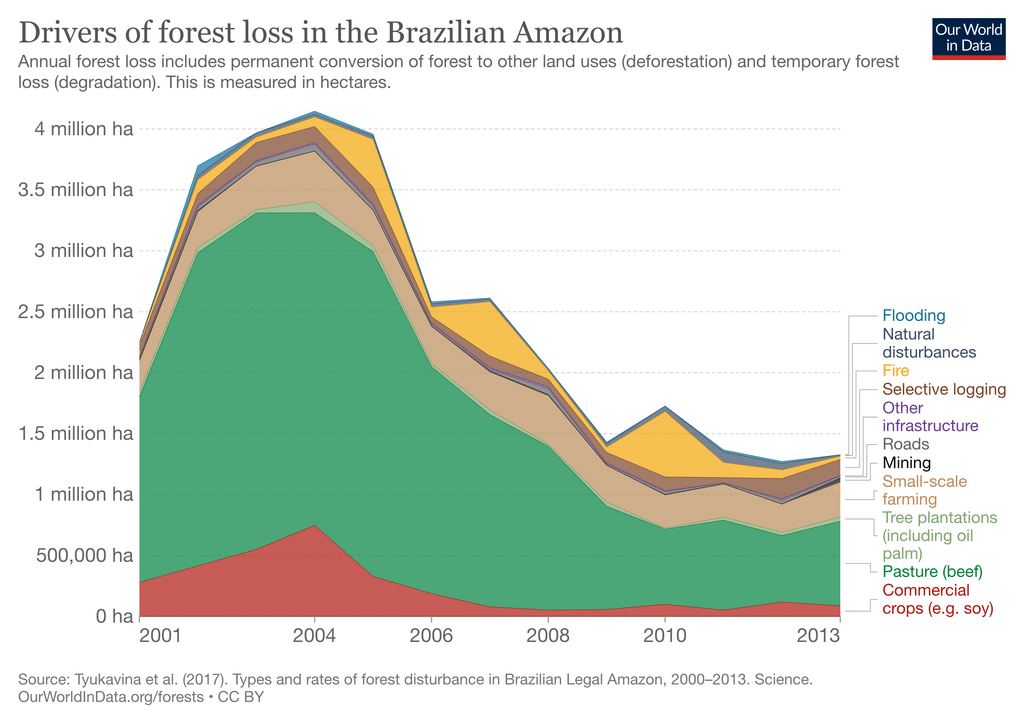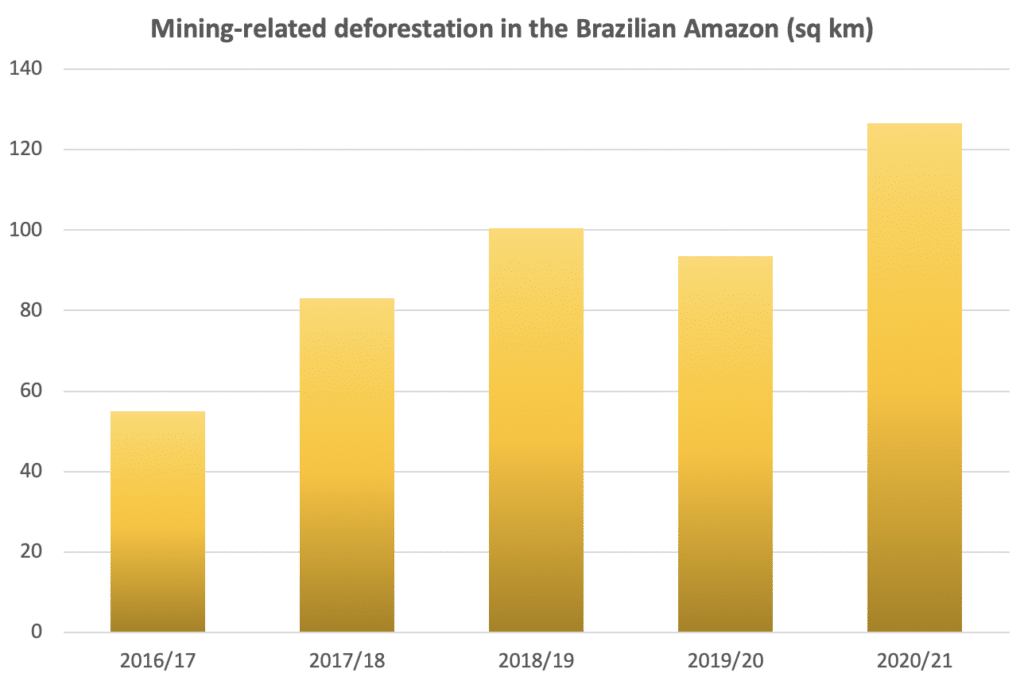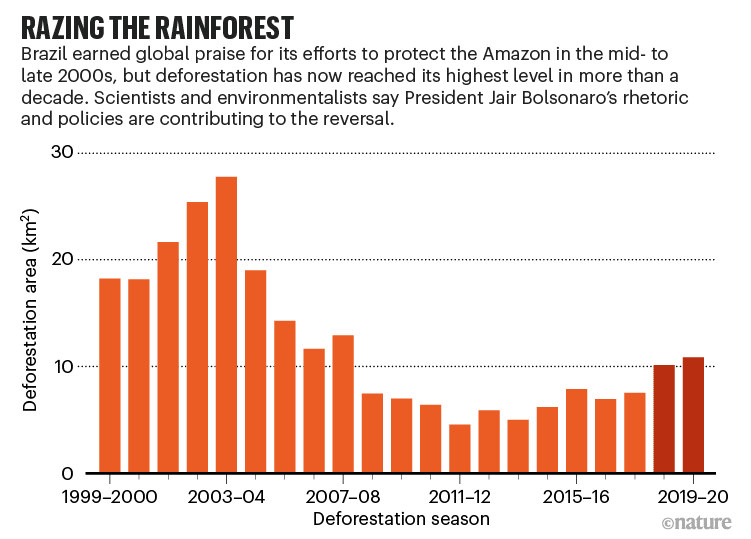The Amazon Rainforest, often referred to as the “Lungs of the Earth,” is facing a grave threat from deforestation. In this article, we present 10 crucial facts about Amazon deforestation that shed light on the alarming rate at which this vital ecosystem is disappearing.
—
The Amazon is the world’s largest rainforest – spanning 6.9 million square kilometres (2.72 million square miles) and covering around 40% of the South American continent. Making up half of the planet’s remaining tropical forests, the Amazon rainforest is also one of the most biologically diverse ecosystems and is home to about three million species of plants and animals, as well as one million indigenous people.
Unfortunately, deforestation is threatening the health and future of this important rainforest, not to mention the wildlife and services that it supports. The victory of former president Lula at Brazil’s presidential elections after years of overexploitation under climate-denier Jair Bolsonaro raised hope for the future of the rainforest, but the road to recovery is long and not without obstacles.
10 Stunning Amazon Rainforest Deforestation Facts to Know About
1. Over 40% of global tropical deforestation occurs in Brazil
Globally, we lose about 5 million hectares of forest a year due to land clearing for agriculture and livestock farming, logging activities to produce materials like paper, palm oil and soy production, as well as gold mining. The Amazon rainforest covers land across nine countries including Colombia and Peru, but around 60% of it lies within Brazil. Despite efforts to protect forest land, legal deforestation is still rampant, and about a third of global tropical deforestation occurs in Brazil’s Amazon forest, amounting to 1.5 million hectares each year.

2. Beef production is the biggest driver for deforestation in the Amazon
The global demand for beef continues to rise. Though the US and China are currently the world’s top beef consumers – they’re responsible for almost a third of global meat consumption – developing countries are on a trajectory to consume four times as much by 2028. An estimated 81,081 square metres of forest land is lost every year for meat production, 80% of which occurs in the Amazon. In the period between August 2018 to July 2019 alone, the Amazon lost over 3,800 square miles, which is equivalent to over 1.8 million football fields, for expansions of pasture for beef production.
3. Gold mining in the Amazon is on the rise
One of more worrying facts about Amazon rainforest deforestation is that gold mining projects have increased across the wider Amazon region in recent years, especially along the Guiana Shield, as the global gold market steadily grows. Mining projects occur deep in the forests and degrade crucial habitats, posing significant risks of water contamination from toxic leaks and soil erosion. Gold mining activities often spreads into protected areas, such as Indigenous Lands and Conservation Units. Studies have also found that gold mining poses detrimental impacts on the health of the forest and limits their regrowth, where forest trees are discovered to have a lower capacity to accumulate carbon, and costing an estimated 2 million tons of forest carbon.

4. Soybean production is a growing threat
Soybean production is responsible for about 12% of global deforestation, which is mainly used as animal feed and to support the massive demand of meat production. Despite the rising popularity of soy milk, tofu and other soybean products, only 19% of soybean production goes into human food products. Brazil currently accounts for around one-third of global soybean production, where in 2018, the country produced 118 million tonnes of soy to support its massive meat production.
5. The Blue Macaw is one of the many species under threat
The Hyacinth Macaw, also known as the Blue Macaw, is native to the Amazon. But the species’ natural habitats and resources grow smaller and smaller every day with illegal logging, agricultural land clearing and urban development. Today, it exists only in small areas including central Pará, the epicentre of deforestation, which saw 203,460 hectares deforested in 2019. While the strikingly blue parrot is currently classified as vulnerable by the International Union for Conservation of Nature (IUCN), they are at the precipice of becoming endangered.
Likewise, Milton’s Titi, an incredibly rare primate that was only first discovered in 2011, and can found only in a small area of lowland rainforest between the Roosevelt and Aripuanã River in the Amazon. As these monkeys cannot swim well or cross mountainous terrain, the live exclusively on treetops and can only remain in this specific area. Due to rising deforestation, the region lost 3,130 hectares of land in 2019, which could prove fatal for the survival of the species.
You might also like: 12 Major Companies Responsible for Deforestation
6. Deforestation has turned the Amazon Rainforest into a carbon source
The Amazon rainforest is a natural carbon sink and provides one of the greatest services for the planet: absorbing and storing carbon dioxide from the atmosphere. Its ability to do so is crucial in our fight against the climate crisis. Yet, as a result of persistent deforestation and a sharp increase in wildfires, the Amazon has been converted into a source of carbon, and is found to emit a greater amount of carbon dioxide than it is absorbing. Forest fires produce three times more carbon than the forests can absorb, thus creating a negative loop. The study also revealed that the forest emitted about a billion tonnes of carbon dioxide a year, equal to the annual emissions released in Japan, the world’s fifth-biggest polluter.
7. Deforestation rates rose sharply under Bolsonaro’s presidency
One of the most startling facts about Amazon rainforest deforestation is that since the President of Brazil Jair Bolsonaro took office in January 2019, deforestation rates have soared to record high levels. According to data from both the Brazilian government and Imazon, an NGO that independently tracks forest destruction, deforestation is distinctly higher under the Bolsonaro administration than at any time during Brazil’s two previous presidencies.
The right-wing former military officer has no qualms in deforestation and openly calls for mining and logging in Indigenous territories. Despite speaking out against “illegal deforestation”, Bolsonaro’s administration has been reducing budgets for law enforcement, forgiving fines for illegal deforestation, and rolling back laws restricting forest clearing. In response to his reckless attitude on deforestation, multiple complaints have been filed against Bolsonaro at the International Criminal Court, accusing him of crimes against humanity for his assault on the Amazon, undermining Indigenous rights, and inciting incursions and violence through calls for mining and land development.

The recent victory of former President at Brazil’s 2022 presidential elections marks a turning point on environmental issues and sparks optimism on the fight against climate change and the future of the Amazon.
You might also like: 10 Deforestation Facts You Should Know About
8. Indigenous communities are key to protecting the rainforest
Indigenous territories and communities play a big role in protecting the Amazon’s biodiversity and unlocking the carbon potential of forest trees and soil. Indigenous people not only have the incentives to protect their homes, but they have boundless knowledge of the lands and best practices for conservation efforts. Studies have found that Indigenous lands are effective buffers against deforestation and while other research saw providing Indigenous Peruvians with smartphones and satellite data has helped overall reduction of tree cover loss in the Amazon. But these efforts are under increasing threat as the current Brazilian government is pushing legislation through Congress that will make it harder for new Indigenous lands to be established and potentially allowing the government to repossess existing lands.
9. More than 100 countries, including Brazil, pledged to end deforestation by 2030
At the COP26 UN climate summit, more than 100 countries committed to halting and reversing deforestation by 2030. And much to the surprise of many, Brazil – despite President Bolsonaro being notably absent at the conference – joined in the pledge. However, many environmentalists are skeptical about Bolsonaro’s commitment in light of his track record and disregard for environmental governance. Though there have been recent efforts to increase forest protection, including hiring 700 more environmental enforcement agents and the allocation of greater funding to the country’s environmental protection bodies, Brazil’s commitment to end deforestation remains to be seen.
Despite slower forest destruction rates throughout 2021, the vital goal set out by the Deforestation Pledge to end and reverse global deforestation by the end of the decade will be missed without urgent action, according to the recently published Forest Declaration Assessment.
You might also like: World Is Not On Track to Meet Global Deforestation Pledge Goal by 2030: Study
10. The EU is banning food imports from deforested areas
Here’s one of the few encouraging facts about Amazon rainforest deforestation – The European Union is moving to ban six agricultural and food commodities linked to areas of deforestation to help protect the world’s most vulnerable forests including the Amazon. Should the legislation pass, European companies would be required to prove that products they sell did not contribute to legal and illegal deforestation or forest degradation.
This story is funded by readers like you
Our non-profit newsroom provides climate coverage free of charge and advertising. Your one-off or monthly donations play a crucial role in supporting our operations, expanding our reach, and maintaining our editorial independence.
About EO | Mission Statement | Impact & Reach | Write for us


















